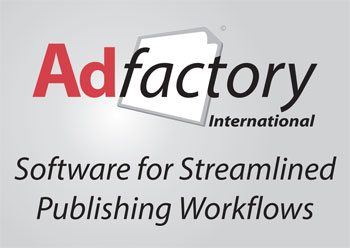
Q: In the ad booking cycle, what are the typical workflow challenges publishers face?
A:
80% of new booked ads are based upon a previous ad, so when an account manager has an advertising customer on the phone, it’s of vital importance that the old ad can be quickly found in the ad booking system, including the ad preview of course. We have come across publishers that were still manually searching in the physical printed paper…Another time consuming area is the proof-of-ad workflow; when this is not automated, this can take lots of time, handled by phone and email, manually sending proofs, corrections etc. An automated proofing system, where advertising customers are able to see their ad previews online and approve or ask for corrections, can be a quantum leap forward in terms of time saving.
Q: To what extent are publishers using 'self-service' options for selling advertising, and what is the potential?
A:
The self-service ad booking portal sounds like it should have great potential for publishers, but in practice, it’s limited to the classified lineage ads and simple classified-display ads. On one hand, publishers want to give their advertising customers lots of freedom when creating their ad. On the other hand, most people don’t have a graphical background… So, either a publisher ends up with a bunch of ads that all look different (which can look awful when put together), or they limit the layout choices using strict templates to ensure a clean page-layout. So, as long as classifieds and family notices remain, they do very well in a self-service environment, saving ad-booking and ad-creation work for the publishers. Coupled with direct online payment, the only thing that the publisher needs to do is… publish them, be that on the page and / or online.Q: Where do you see most opportunity for publishers increasing ad revenues?
A:
There are two areas where ad revenues can be increased. One is to offer packages consisting of multiple publication channels, ie. a combination of print, web, social media, newsletter – the possibilities here are still often not fully deployed, even though the cost of the non-print channels are much lower.The other area is ‘branded content’ (in the old days, called ‘advertorial’). Publish articles that support the advertising, or even just (paid for) articles, where the editor is actively involved in the writing. Again, as with ad booking, an automated proof and correction workflow can save lots of time!
Q: In the editorial creation process, where is most time currently wasted?
A:
When having external correspondents supplying copy via email, editors have to copy / paste articles, determine styles for headers, intros etc, find and assign photographs and do the editing / correction. This can be nearly a day’s work! An online editorial portal, like the one AdFactory offers, allows correspondents to directly write into the editorial system, assign styles, add pictures etc themselves. The only thing the editor needs to do is open the article, do the editing and publish it, to print and / or websites.Another time consuming area is when you have several editors working on the same publication, and they have to more or less continuously discuss who’s doing what and where. With an online page-planning system, this all happens automatically; the actual production-status of the publication is always up-to-date and visible, allowing clear insight of how much space is left.
Q: What is the potential for productivity gains through improved workflows?
A:
There are a number of areas:- The automation of proof-workflows for both adverts and articles can save lots of time. Our experience shows that per advert / article that needs proofing, a time saving of 10-15 minutes is easily achievable!
- Delivering print-ready classifieds PDFs via a self-service portal also saves about 10 minutes per ad; no manual booking into the system required, no ad design needed, and with online payment, no invoicing / payment checking.
- Around 5-10 minutes saving per article can be easily achieved when articles from correspondents are submitted via the online editorial portal (as described above).
- The online page-planning system not only makes editors’ time more efficient, it also delivers peace of mind, by presenting them with a continuously up-to-date page status overview.
Q: When publishers are considering changing editorial or advertising platforms, how can risk be mitigated?
A:
When changing to our hosted advertising or editorial systems, this can all be configured aside of normal operations. When everything is ready and set up, a publisher can simply do a ‘test-run’ and even change-over in phases, so that not all existing workflows are changed at once.
About us
AdFactory-International, active in the Netherlands since 2003, develops and delivers online hosted advertising and editorial workflow software for publishing companies. Initially targeted to medium size publishers of weekly newspapers, it has now evolved to supplying flexible publishing-software solutions for all kind of newspaper, magazine and online publications. Currently over 700 titles in the Netherlands, Belgium, Germany, Ireland, UK and New Zealand are published using AdFactory software.
Tel. +31 85 773 7743
Mobile +31 64749 2205
Email: rob@adfactory.nl
Web: www.adfactory.nl










